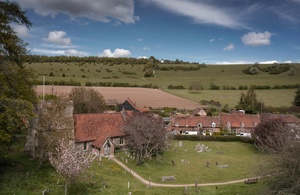Natural England announces landmark new programme for protected landscapes
Proposals for four new protected areas, and ambitious new programme to increase our protected landscapes and find innovative ways to bring nature and people closer together.

Turville village, Chiltern Hills. Credit: Hedley Thorne.
Natural England is today (Thursday 24 June) announcing proposals for new protected areas across England, alongside an ambitious, landmark programme to examine how more areas could benefit from landscape improvements, and deliver more for people and nature.
Under these proposals, four areas will be considered for greater protections, with potential to deliver over 40% of the additional 4,000km2 required to meet the Prime Minister’s commitment to protect 30% of our land by 2030 for nature. They will also help deliver on the Government’s commitment to safeguard more of England’s beautiful and iconic landscapes for future generations as outlined in its 10 Point Plan for a Green Revolution.
Spread across the country, areas being considered for designation include:
- Yorkshire Wolds AONB – a tranquil landscape of rolling hills, valleys and open plateaux interspersed with ancient woodland, chalk streams, farm holdings and historic villages, extending north from the River Humber.
- Cheshire Sandstone Ridge AONB – a diverse, distinctive, and celebrated landscape located in the heart of Cheshire, in close proximity to the large populations of NW England, rich in heritage, archaeology, wildlife, and culture.
- An extension to the Surrey Hills AONB – to consider including areas of high scenic quality including chalk grassland, parkland and historic features adjacent to the existing AONB.
- An extension to the Chilterns AONB – to consider many special features including chalk streams, magnificent beechwoods, native woodland and wildflower-rich hills, bringing nature closer to populations in North London.
Today’s announcement also takes forward the recommendations of the major independent review – led by writer Julian Glover – into our protected landscapes. Natural England welcomed the Review which set out a compelling vision for more beautiful, biodiverse and accessible National Parks and AONBs. It warned that challenges such as climate change, biodiversity loss, and a changing, urban society mean that new approaches are needed to get the most out of England’s most-loved landscapes.
Responding to the Review’s calls for bold action, and in addition to the proposals for two new AONBs and extensions to two existing AONBs, Natural England will be considering proposals for new National Nature Reserves. It will also implement a more collaborative and swifter process to new National Park and AONB designations.
Natural England has also set out its ambition to develop new approaches that will drive nature recovery and improve people’s connection with nature, particularly focusing in and around towns and cities. The programme will focus on improving people’s quality of life, addressing inequalities in access and connection to the natural environment which have been well-evidenced through the Covid pandemic. This could include building on the idea of ‘national park cities’, focusing nature restoration next to where people live.
Chair of Natural England Tony Juniper said:
The benefits of our stunning, protected landscapes go far beyond their visual appeal, from enhancing our wellbeing, providing places for living and working communities, to making an important contribution to nature recovery and combating the climate emergency.
I’m delighted to see the growth and protection of these areas is an increasingly prominent Government priority. I look forward to working closely with Defra, National Parks England and the National Association for AONBs to make these special areas richer in nature, accessible for all to connect with for their well-being and to deliver a green recovery from the Covid-19 pandemic.
Also being announced today, a strategic and visionary map for ‘England in the 21st Century’ will be developed, reflecting the spirit of the ‘Hobhouse Map’ which led to the establishment of the first National Parks 70 years ago.
To create this England-wide assessment, Natural England will work with stakeholders and communities to identify conservation needs across England, including any remaining places suitable for future National Park or AONB designation and those places where alternative forms of action will be more appropriate and are wanted by local communities.
Nature England is also transforming its joint working with National Parks England and the National Association for AONBs, through a new delivery agreement. This will deliver a step change in joint delivery of multiple and integrated benefits for people, nature and climate through England’s finest landscapes.
Today, the Environment Secretary will set out the government’s support for improved nature recovery and public access in National Parks and Areas of Outstanding Natural Beauty ahead of a consultation on draft proposals later this year. The statement will also outline a new Farming in Protected Landscapes programme to support farmers and other land managers to improve their landscapes and create thriving destinations for communities to enjoy. As Government’s statutory landscape adviser, the proposals for new designations will be delivered by Natural England, who will also be supporting the new programme for farmers in protected landscapes.
Natural England is Government’s Statutory Advisor on landscapes in England, with duties and powers to conserve and enhance landscapes that include the designation of National Parks and Areas of Outstanding Natural Beauty. The designation process is likely to take several years and will be a collaborative process including local stakeholders at every step.
These new areas of landscape designation have been selected through an evidence-based assessment from proposals that have been made to Natural England over the last 10 years.